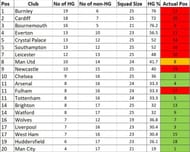
It's no doubt that the English Premier League is the most global league amongst all the top leagues in the world. When it comes to TV viewership, the Premier League is way ahead of its peers.
Part of the reason for the EPL's popularity is its better marketing and the exciting and unpredictable nature of the league. Even footballers seem to be swayed by these reasons and hence eventually move to the top clubs in the land.
Moreover, the distribution of TV money among the 20 clubs is fairer when compared to other leagues. Hence even mid-table and newly promoted clubs can attract big foreign talent to their clubs.
The Premier League is often the first to be blamed for the English National Team's underachievements in past FIFA and UEFA tournaments. Thus, to ensure the development of local talent, the homegrown player rule was introduced by the FA. Their purpose behind this move was to have more strict regulations on the signing of foreign players.
A homegrown player is any player that has been with an English team for at least three years before the age of 21. The cap on the number of non-home-grown players available to each squad was 17 as per this rule.
Below is an alternative Premier League table ranked purely based on the number of homegrown players at each club.

Some of the key takeaways from the above table are:
Burnley have the most homegrown players out of any club with an impressive 19 out of their 25 man squad being homegrown but, they sit 12th in the actual Premier League table after 8 games.
Manchester City has only 4 homegrown players, meaning a measly 19% of their squad is homegrown however, the defending champions are unsurprisingly at the top of the table so far.
Looking at the promoted clubs, there is a vast difference between Cardiff City (a homegrown % of 72) and the other two, Fulham (HG% = 33.3) and Wolves (HG% = 32). But in real life, Wolves are a lofty 7th with Fulham just above the relegation zone in 17th while Cardiff is bottom.
Remarkably, only 6 clubs have an above 50% homegrown composition in their squads - Burnley, Cardiff, Bournemouth, Everton, Crystal Palace and Southampton.
And finally looking at the top 6 Manchester United have the best homegrown composition at 41.7% with Chelsea at 36%, Arsenal and Spurs at 33.3%, Liverpool at 30.4% and as seen earlier, City at 19%.
The table doesn't convey that having more homegrown players means more success which probably is true.
However, English football has a lot of talent as demonstrated by the Young Lions performing impressively in every major tournament in 2017. England won the u-17 World Cup, the u-20 World Cup, the Toulon tournament and the u-19 Euros all in 2017. The youth sides also performed exceedingly well in other tournaments but narrowly missed out on trophies with a semifinal defeat in the u-21 Euros and a heartbreaking final loss in the u-17 Euros last year.
English fans will be hoping that the current generation can develop into superstars and go on and deliver their nation a first major tournament since 1966.
